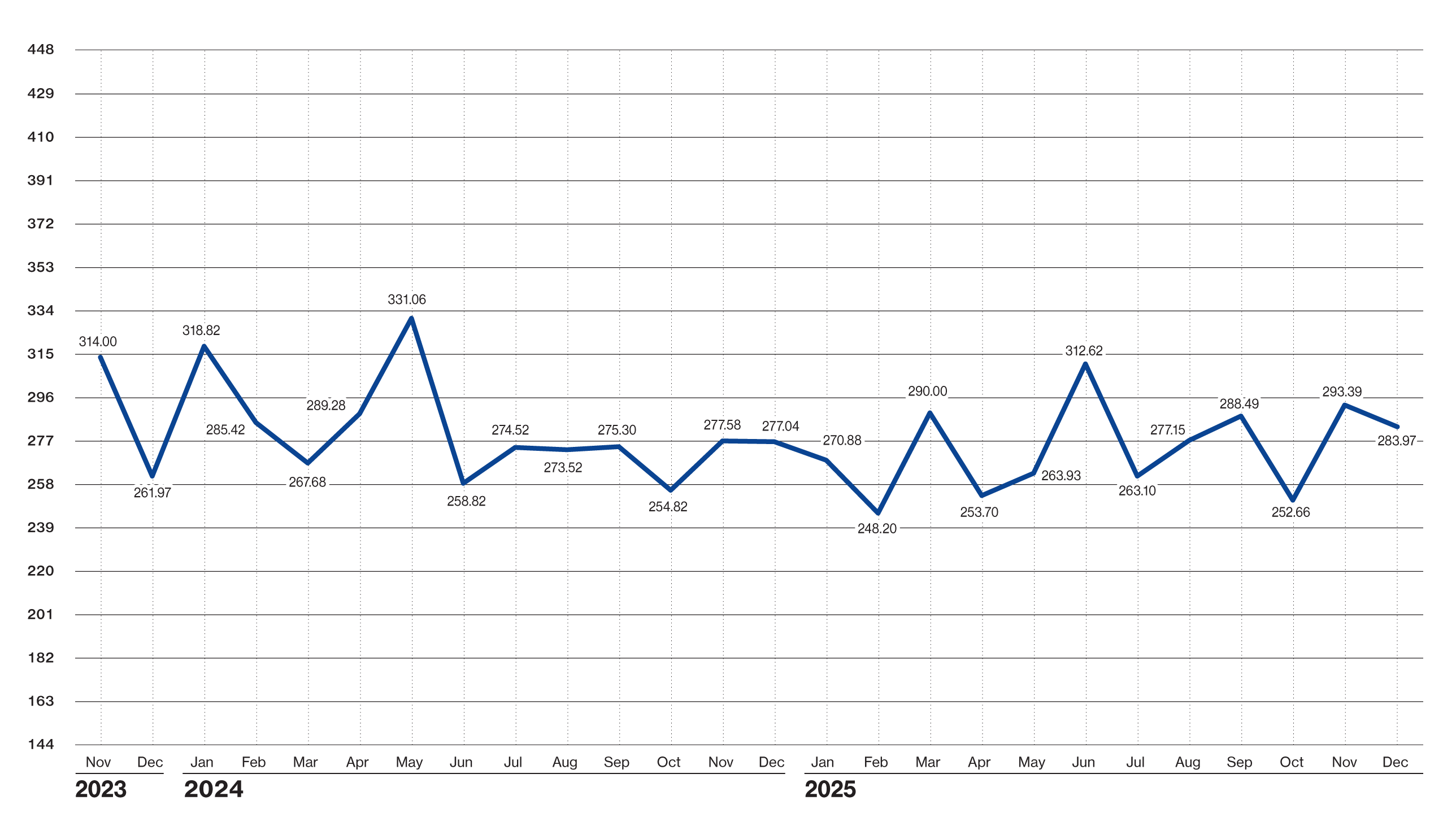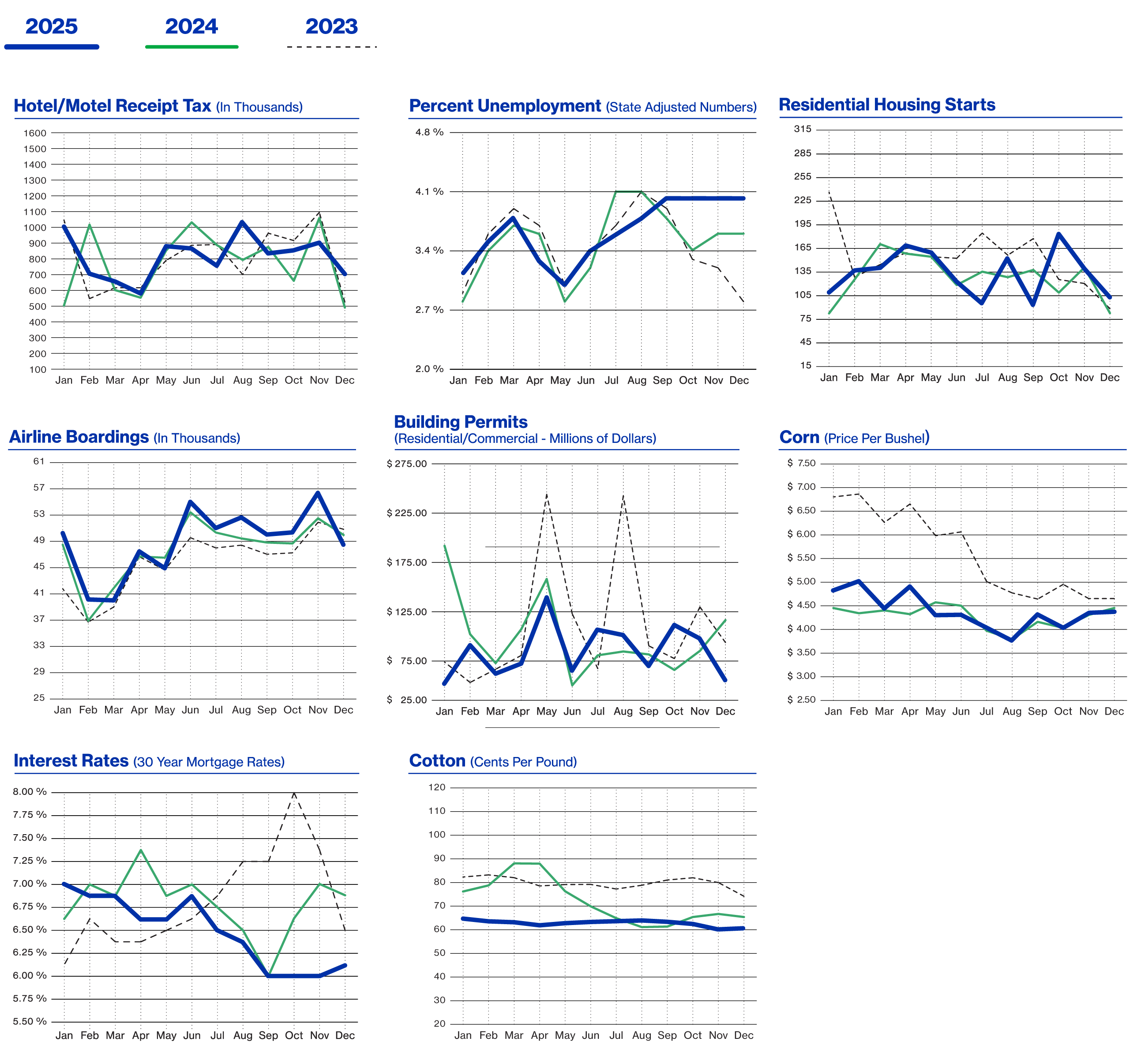December 2025
Lubbock’s economy is steady with residential construction outperforming 2024 sales and less commercial construction than we saw in 2024.
Both new and used car sales were up, and retail sales were up.
Lubbock continues to benefit from a strong trade base, with retail sales up 9% from the same period last year and YTD sales up 3%. New car sales increased 5% and used car sales rose 3%.
Tourism remains strong, with higher hotel sales driven by Texas Tech football weekends, though airline boardings are down 5%.
We have not received updated job numbers from the state due to delays caused by the federal government shutdown. Without official data and with ICE-related concerns, the job market may be weaker than it appears.
With many new jobs created by Leprino Foods, residential building permits have outperformed 2024 in 9 out of 11 months, while other construction has declined slightly YTD.
Residential construction continues to outpace last year, with 103 starts compared to 88. However, commercial building activity has slowed YTD. Median house prices are up 3% this month, though the homes sold were less expensive. With interest rates coming down, there is some pent-up demand for increased commercial construction.
Energy markets were mixed. Oil prices fell 20%, while natural gas prices rose 26%. Oil rig activity remained steady.
Agriculture improved thanks to better cotton yields. Wheat prices dropped 10%, corn 1%, and cotton 7%. Fat cattle prices increased 21%, but milk prices declined 15%. Cotton Harvesting is winding down and improved yields from last year’s crop.
Economic Pulse

| Economic Components | Current Month | Last Month | Last Year |
|---|---|---|---|
| Index (Base Jan. 88 @ 100) | $ 283.97 | $ 293.39 | $ 277.58 |
| Sales Tax Collections | $ 9,443,527 | $ 10,548,228 | $ 8,647,075 |
| Sales Tax Collection-YTD | $ 110,007,144 | $ 100,563,617 | $ 106,646,261 |
| New Vehicle Sales | 1,028 | 1,377 | 974 |
| Used Vehicle Sales | 1,846 | 2,590 | 1,795 |
| Airline Boardings | 48,003 | 56,220 | 50,667 |
| Hotel/Motel Receipt Tax | $ 702,350 | $ 905,198 | $ 408,361 |
| Population | 272,086 | 272,086 | 263,648 |
| Employment - CLF | 0 | 0 | 175,806 |
| Unemployment Rate | % 0.00 | % 0.00 | % 3.60 |
| Total Workers Employed (Household Survey) | 0 | 0 | 169,524 |
| Total Workers Employed (Employers Survey) | 0 | 0 | 163,700 |
| Average Weekly Wages | $ 1,044.00 | $ 1,044.00 | $ 1,024.00 |
| Gas | 78,603 | 78,499 | 77,738 |
| Interest Rates: 30 Year Mortgage Rates | % 6.125 | % 6.000 | % 6.875 |
| Building Permits Dollar Amount | $ 49,492,562 | $ 91,720,226 | $ 120,004,733 |
| Year to Date Permits | $ 972,265,268 | $ 922,772,705 | $ 81,001,585,078 |
| Residential Starts | 103 | 138 | 88 |
| Year To Date Starts | 1,495 | 1,392 | 1,481 |
| Median House Sold Price | $ 240,000 | $ 240,000 | $ 234,000 |
| Drilling Rigs In Panhandle | 11 | 10/td> | 9 |
| Oil Price Per Barrel | $ 56.75 | $ 59.82 | $ 70.83 |
| Natural Gas | $ 4.03 | $ 4.33 | $ 3.20 |
| Wheat Per Bushel | $ 5.30 | $ 5.45 | $ 5.86 |
| Fed Cattle Per CWT | $ 229.00 | $ 230.00 | $ 190.00 |
| Corn Per Bushel | $ 4.37 | $ 4.30 | $ 4.43 |
| Cotton (Cents Per Pound) | $ 60.69 | $ 60.60 | $ 65.16 |
| Milk | $ 16.00 | $ 17.21 | $ 198.75 |
Prepare for the majestic dance of disclaimers!
This document was prepared by Lubbock National Bank on behalf of itself for distribution in Lubbock, Texas and is provided for informational purposes only. The information, opinions, estimates and forecasts contained herein relate to specific dates and are subject to change without notice due to market and other fluctuations. The information, opinions, estimates and forecasts contained in this document have been gathered or obtained from public sources believed to be accurate, complete and/or correct. The information and observations contained herein are solely statements of opinion and not statements of fact or recommendations to purchase, sell or make any other investment decisions.
Economic Pulse Charts

{beginAccordion h3}
2025 Economic Analysis
{endAccordion}
{beginAccordion h3}
2024 Economic Analysis
{endAccordion}
{beginAccordion h3}
2023 Economic Analysis
{endAccordion}

